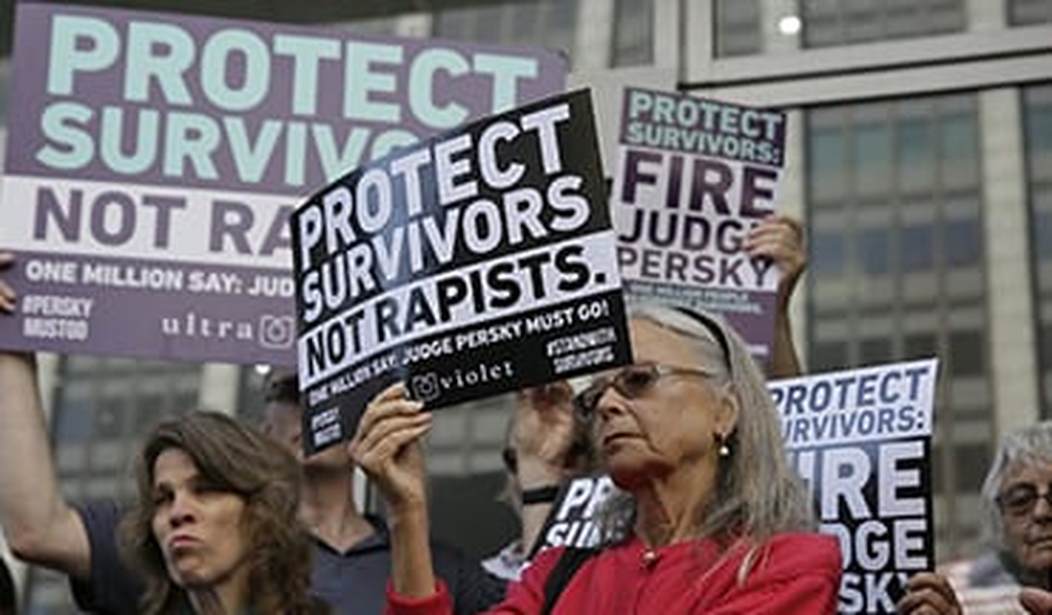We live in a culture that has become so heavily sexualized that we are no longer able to see clearly or think rationally. Just about everything, it seems, now comes down to sex, which is, on any reasonable scale of values, merely one of many human preoccupations—central, of course, but still only one of many human interests, desires and activities. The all-consuming importance sex has acquired in contemporary thought, discourse and legislation, amounting almost to a demonic possession, is an infallible sign of both intellectual frivolity and cultural degeneracy.
We are lectured that women are always innocent in cases of sexual assault and that men are invariably guilty, when instances like the Ghomeshi trial, the Duke lacrosse fraud, the “mattress girl” hoax and many others prove the opposite. The result of our morbidly sex-obsessed culture is that we have become increasingly prone to waves of national hysteria, vigilante pursuits of ostensible felons, and the social valorization of mob justice. Less and less in cases of a sexual nature are we concerned with the impartial assessment of evidence that constitutes the basis of a viable justice system; the time-honored principles of presumption of innocence and burden of proof are gradually yielding to the “preponderance of evidence” model—which means the accused is found guilty if judge or jury determine that it is more likely than not that he (almost never she) committed the crime. Nothing here about “beyond a reasonable doubt.” Our modern Furies will pin their prey to the corkboard of their prurient passion with lepidopteran precision. That a process of this nature is a gross travesty of the administration of justice appears to have escaped the attention of the new warrior rabble among us.
The latest example of such deliberate obscurantism involves the highly publicized Stanford incident in which student and competitive swimmer Brock Allen Turner was originally arraigned on two counts of rape and three counts of assault on a young woman he’d met at a frat party—the prosecution’s plan seemed to be to throw everything at the defendant and hope something would stick. He was eventually sentenced to six months in prison on three counts of assault. The mounting frenzy of hatred soon reached epic proportions, with millions sympathizing with the woman—henceforth Jane Doe—and lobbying for both a harsher sentence and the recall of the white male judge—who was also the recipient of death threats. And yet the case is far from being as open-and-shut as an indignant population of vigilantes claim; indeed, it is shrouded in layers of ambiguity.
This did not stop a posse of angry and sanctimonious avengers, journalists, talking heads and feminists from denouncing Turner as some kind of monster. Even the more censorious brand of respectable conservatives got into the act, many of whom have plainly not researched the minutiae of the case and, sad to say, really don’t know what they are talking about. Steve Green, Scott Ott and Bill Whittle, all good men and true, did not cover themselves in glory in their Right Angle video discussion of the Stanford trial. They bought the accepted narrative.
Here is the basic information pertaining to the case, as per various media accounts, the court file, the police report cited in Cosmopolitan (which, if you wait long enough, flips to a full-page ad for “The 31 Sexiest Movies”—what else!) and which is also embedded in the court file, and the victim impact statement (cited in BuzzFeed, naturally), a lengthy but indispensable read. One must keep in mind that these instruments are not a cold, objective, God’s-eye view of the event, but, as my attached commentary below suggests, a human survey subject in considerable measure to bias, interpretation, conjecture and inference. While interesting and necessary for research purposes, these documents taken together do not establish an airtight case for Turner’s guilt. The reader should examine them for himself or herself.
- Jane Doe was drinking (4 shots of whiskey and champagne, she says) before she and her sister went with a mutual friend to a frat party. Her mother dropped them off around 11 p.m., both daughters already in a state of partial inebriation. Yet it is not Jane Doe’s mother—who should have known better—who has had to face public opprobrium; it is Turner’s father who has felt the brunt of public outrage for defending his son.
- By 12 a.m., they were all in their cups. The sister left the party to help a drunken friend home, leaving Jane Doe standing on the back porch of the frat house. Between then and 12:30, the “victim” spoke with her boyfriend on the phone several times. If Jane Doe was on the verge of complete incapacitation, her sister’s departure and her facility in punching numbers on a cell phone are, to put it mildly, rather curious.
- At 1:01 police officers were dispatched to the scene, where they found the woman unconscious and Brock Turner being held by two witnesses who had bicycled by and found him on top of the unconscious woman. No one saw what happened between 12:30 and (approximately) 12:50 or 12:55 when the two witnesses happened upon the scene.
- Another witness declares that he saw a man standing over an unconscious woman and taking a picture of her with his cell phone (maybe) or maybe just shining a light on her—the witness was drunk and he’s not sure. There is speculation that Turner sent around a picture of the woman’s breast to friends, but police could not find the picture on his cell phone when they checked afterwards.
- A woman has come forward to say that Turner was acting “aggressively” at a party the week before, trying to dance with her and touch her. As a student I attended many parties in which such behavior was pro forma. The girls were often no less forward. Nobody saw it as denoting a criminal mindset. But then, we were not living in Salem redux.
- Jane Doe claimed in her impact statement that had she not been assaulted on that night, Turner would have victimized someone else in her stead. This is a mere inference that cannot possibly be substantiated and serves only to render Turner culpable for an act he did not commit, helping to paint him as a sexual predator.
- Turner’s blood alcohol level was .17%, twice the legal driving limit, and Jane Doe’s was .24%, three times the legal driving limit. It is likely that both experienced severely impaired judgment. This means that neither of their stories can be accepted at face value; memory lapses and distortions of reported details are unavoidable in such circumstances, and personal depositions are wholly undependable. Who knows what went on between Turner and Jane Doe before the drunken encounter? Was Turner the salivating fiend he is depicted as? Was Jane Doe the innocent victim most everyone has empathized with? The young woman affirmed that she had no recollection of what took place. Why then should Turner, who was also saturated, be held fully accountable? This smacks of a double standard.
- Turner’s high school guidance counselor came to the young man’s defense, calling him an “outstanding student” of good character, as did a high school friend, Leslie Rasmussen, the drummer of the Indie band Good English. Not for long though. The backlash was so severe that the counselor publicly apologized for supporting Turner. The drummer also succumbed to the pressure after several gigs were cancelled for her apostasy. Are we to assume that both character witnesses suddenly and simultaneously realized they had been dreadfully wrong about Turner over the years in which they knew him and recanted their advocacy owing to some mysterious, overnight revelation? Or might some other, more self-interested factor have come into play? At any rate, one can gauge the degree to which mob sentiment has pejoratively shaped attestations on Turner’s behalf. It is obviously career suicide to publicly oppose what has come to resemble a community lynching.
- The police report initially stipulated that “a rape occurred on the Stanford University campus,” although there was no forensic evidence of rape and the charge was later withdrawn. The two aforementioned witnesses who came upon the scene claimed they saw Turner pumping his hips as he presumably raped the woman, which shows once again how unreliable such testimony is. One may wonder whether they were simply deceived or seizing an opportunity to cash in on notoriety. No matter, the die had been cast. In the mind of a feverish public intent on retribution, before or despite the facts, judgment had already been rendered. The woman was innocent and the man was guilty.
- Officer B. Shaw deponed in the police report that when he observed Turner, who had fled the scene and been chased down, being detained by the two witnesses who had apprehended him, “he had what appeared to be a cylindrical bulge consistent with an erect penis underneath his pants.” Pardon my indelicacy, but this is a long time in which to retain an erection, especially under the circumstances. And the policeman’s fixation seems salaciously crude and factually unverifiable. This plainly is not the way to build a plausible case. The whole episode is reminiscent of the keystone cops and would induce laughter were it not so fateful.
Questions pose themselves. Did Jane Doe pass out before or while they were, in Turner’s words, “making out”? Did he force her or was the encounter consensual? The entire sequence of events remains obscure and no clear determination can be made. Neither participant was sober and no witnesses have come forward to credibly report on the in flagrante moment or on the crucial minutes leading up to it. Are we to believe that Turner dragged an unwilling or semi-conscious woman from the frat house without anyone noticing or objecting? Or was there, as seems at least feasible, prior consent or mutual nonverbal agreement as they staggered out together? Clearly, what is needed is not another kangaroo tribunal presiding over resident uncertainties, but a campus-wide campaign warning students about the perils of getting blotto.
My own view is that the entire process reeks to high heaven. When one frankly considers the evidence at hand, the skewing of inferential logic that attended the case, and the climate of anti-male hysteria in which such proceedings take place, the judge’s verdict may come to seem not unduly lenient but unfairly punitive. I concur with my wife Janice Fiamengo’s conclusion, aired in a recent video installment in her Fiamengo File series: “[Turner] doesn’t deserve any time in jail, and the judge who gave him six months…does not deserve to be recalled as a ‘privileged’ white man giving his co-whitey a privilege pass. In my opinion, both Turner and the young woman should have been given a stern lecture by the police about their irresponsible sexual behavior and drunkenness, should have been made to feel ashamed, and should have been encouraged to exercise self-restraint in the future. Both would have benefited from counseling.”
Extrapolating from the comments to the video, it is obvious that many people, blinded by the pall of media obfuscation and significant omission of detail, did not have the pertinent facts at their disposal, believed that Turner had been convicted of rape rather than assault, and were not aware that Jane Doe’s conduct was influenced by excessive alcohol consumption. Unaware of the gaps and problematic elements that compromised the eventual judgment, they had, in effect, endorsed the popular construction of the case. In the light of more complete information, many who had urged a stiffer sentence are now seriously reconsidering the affair. When delirium goes viral, not only the defendant but justice itself is harmed. The vigilantes may as well have adopted a quadrate version of Koran 17:32 as their watchword: “And do not approach unlawful sexual intercourse. Indeed, it is ever an immorality and is evil as a way.” That is, they decide what is or is not “lawful,” and the admissibility of any sexual encounter is made to conform to their codified preoccupations. What is undeniable is that ideological zealots have been given free rein and the hunt to incriminate men for sexual misconduct regardless of corroborative blur is in full swing.
The Stanford case serves as a perfect illustration of how the feminist ideology in collusion with the ravages of mob justice do their miserable work. The event is viewed through the warped lens of a phobic obsession with sex to the exclusion of mitigating factors: alcohol, hormones, youth, the natural preoccupations of both sexes. When the evidence shows that a rape has occurred, the perpetrator should be punished to the full extent of the law. But in a gynocentric culture in which men are considered sexual raptors by nature, in which any sexual episode or misdemeanor is increasingly regarded as rape or assault tout court, and armies of wrathful puritans are on the march to accuse, prosecute, judge and sentence the putative offender while women are absolved of the slightest iota of intention or responsibility, the miscarriage of justice is virtually assured. No wonder the MGTOW movement (Men Going Their Own Way) is gathering momentum and the relation between the sexes is gravely fractured. We are creating a bed of stones to lie in.
Critics of my argument–or of anyone who expresses skepticism of how the affair was interpreted and adjudicated–will without doubt launch accusations of callousness or prejudice or even worse—unforgiveable sexism. This reaction will not be based upon a careful sifting of evidence or scrutiny of probabilities, but on the preformed assumptions of pure emotionalism. I expect volleys of hate.
Nevertheless, the fact remains that thanks to the inroads of the feminist agenda into the justice system and, indeed, into the minds of the credulous and self-righteous herd of neo-Cathars who can think of nothing except the evil nature of men (that is, heterosexual men); the pristine nature of women; sex, gender and deviations from the norm, whether pro or con; and the irrelevance of biological reality, we have become a foolish, intolerant and, I’m sorry to say, a mentally retarded society.
May God the Father and Mother Nature help us.










Join the conversation as a VIP Member